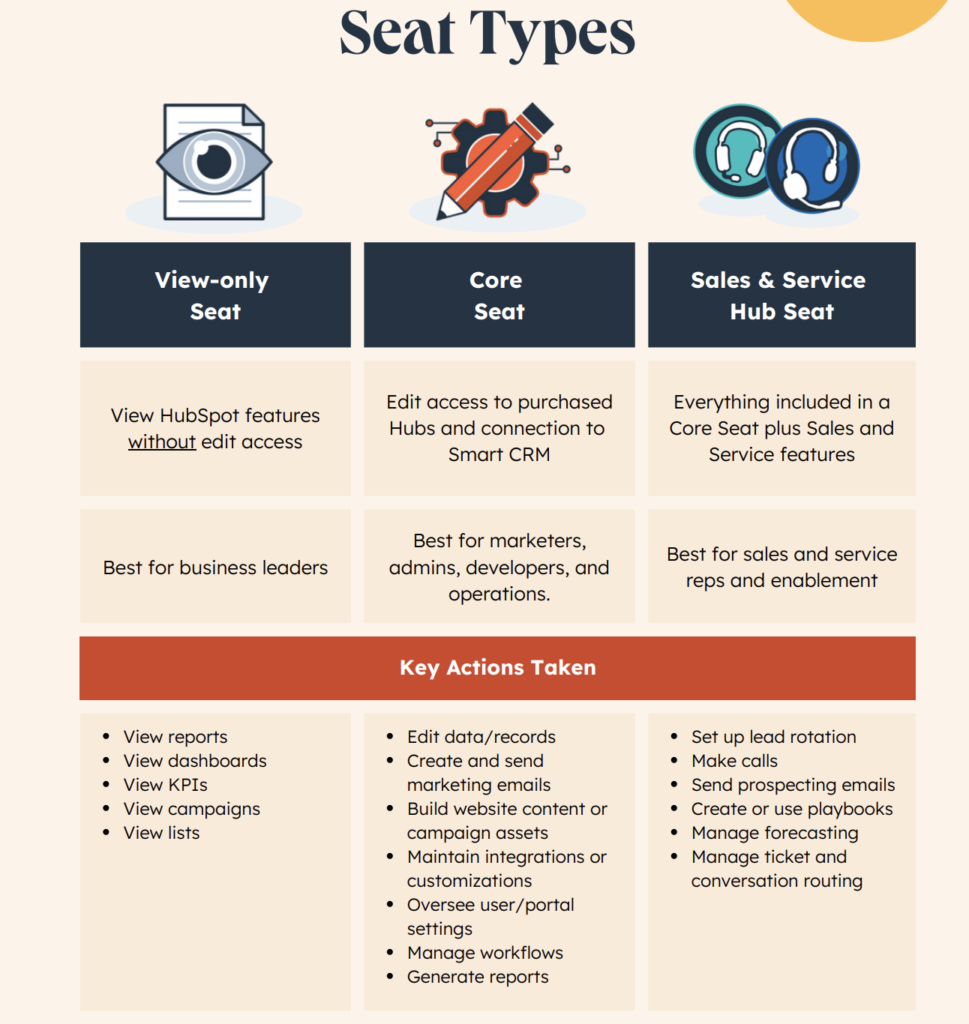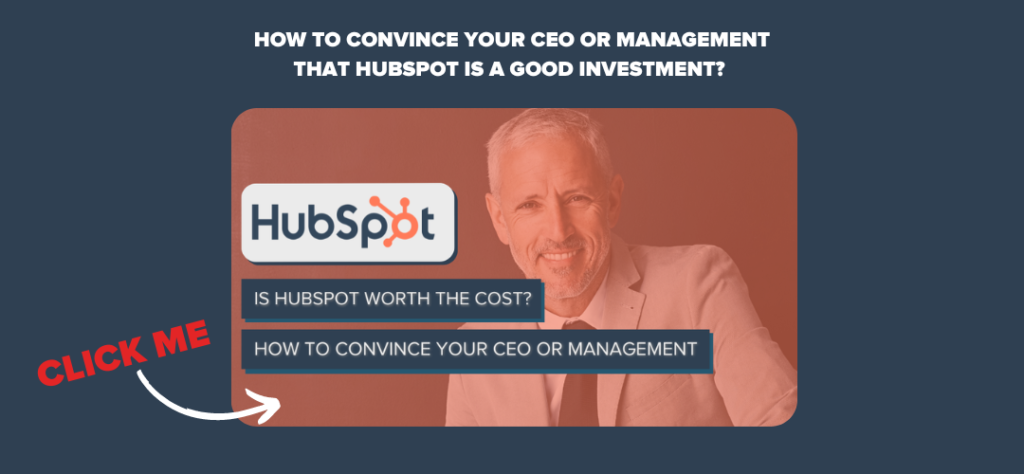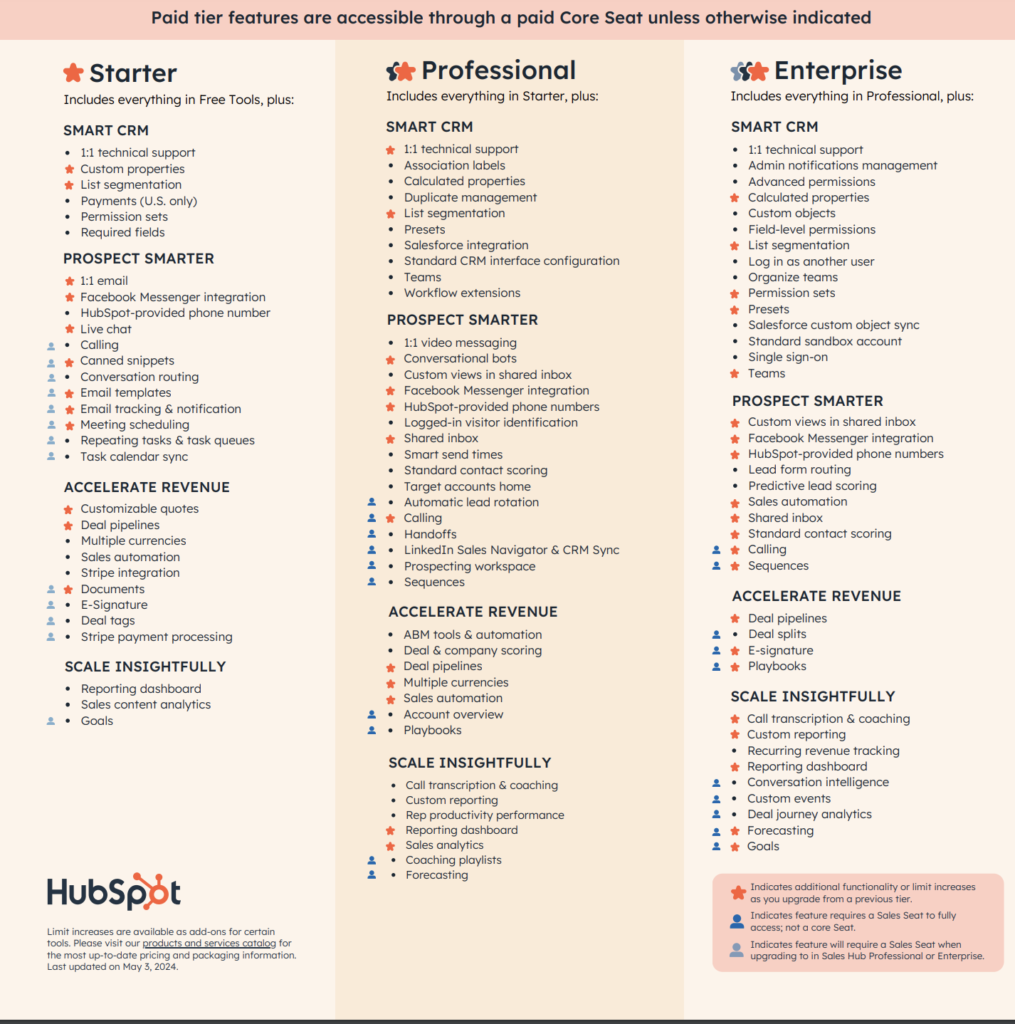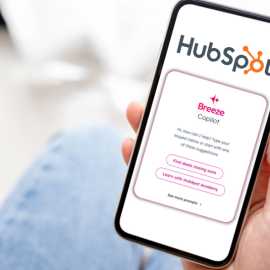You’re trying to optimise your team’s workflow in HubSpot, but you’re not sure which type of seat to assign to each user. It sounds simple at first—just pick between Core Seats and Standard Hub Seats, right? But the more you dig into the details, the more it feels like you’re wading through a maze of features, permissions, and price points.
You’re not alone in feeling this way.
We have so many clients asking us this question, and it almost always comes up when we’re onboarding a new business onto HubSpot.

It’s an important decision to make because choosing the wrong seat type can limit your team’s efficiency—or worse, blow your budget without delivering value.
Having worked on hundreds of HubSpot portals across many industries and companies of various sizes, we know exactly what to do when it comes to HubSpot seats.
By the end of this article, you’ll walk away with a clear understanding of the differences between Core Seats and Standard Hub Seats. We will break down what each seat offers, who should be using them, and how to make the best choice for your team.
What Are HubSpot Core Seats?
HubSpot Core Seats are designed for users who need access to most of HubSpot’s powerful features, but without the specialised tools that come with sales or service seats.
If your team members are responsible for marketing, operations, or overseeing the company’s CRM and workflows, Core Seats are likely the right choice.
Here’s what you get with a Core Seat:
- Edit access to all purchased HubSpot hubs: This includes the ability to manage your CRM, create marketing campaigns, oversee workflows and build website content or campaign assets
- Integration with HubSpot’s Smart CRM: Core Seats allow users to interact with the Smart CRM, which connects all data across sales, marketing, and service hubs, creating a seamless experience for managing customer interactions. This means core seats allow users to maintain integrations or customisations
- Reporting and analytics: Users can generate reports, set up dashboards, and track KPIs, making it ideal for those who need to monitor performance but aren’t directly involved in sales or service delivery
- Access to Settings: Users with Core Seats will be able to oversee user and portal settings
Read: How to convince your CEO or management that HubSpot is a good investment?

Who Should Use Core Seats?
Core Seats are ideal for team members who perform strategic and operational tasks. For example:
- Marketing managers who need to create campaigns, manage content, and oversee integrations
- Operations managers who are responsible for workflows, data management, and system customisations
- Executives who need access to reports and dashboards without delving into daily sales or service activities
While Core Seats offer robust functionality, they don’t provide specialised sales or service features, such as playbooks or direct access to customer support tools, which are reserved for Standard Hub Seats.
What Are HubSpot Standard Hub Seats?
Standard Hub Seats—whether for Sales, Service, or other Hubs—are tailored for team members who need deeper, more specialised functionality to drive specific business outcomes.
These seats build on the foundation of Core Seats, adding powerful tools designed to enhance productivity in sales, service, or both.
Here’s what you get with Standard Hub Seats:
- Sales Tools: For those using Sales Hub Seats, features like playbooks, sales automation, and lead rotation become available. These are crucial for sales reps and managers who need advanced tools for outreach, pipeline management, and performance tracking
- Service Tools: For Service Hub Seats, you gain access to features such as ticket routing, conversation management, and customer satisfaction surveys, making these seats essential for customer support teams
- Advanced Customisation and Automation: With Standard Hub Seats, users can access more advanced settings like custom reporting, predictive lead scoring, and Salesforce integration, giving teams greater flexibility to tailor HubSpot to their specific needs
Read: Is HubSpot powerful enough for large enterprise companies?

Who Should Use Standard Hub Seats?
Standard Hub Seats are designed for sales reps, service teams, and anyone who needs specialised tools to deliver on their roles.
These seats are best for:
- Sales teams who need access to tools like email templates, calling, sales automation, and playbooks for more efficient lead management and follow-ups
- Service reps who manage customer inquiries, need to route tickets, or handle live chat, ensuring quick responses and efficient customer service
- Sales and service managers who oversee team performance, manage forecasts, and need detailed analytics to drive strategy and decision-making
If your team requires tools specifically tailored to close deals, manage pipelines, or deliver high-quality customer service, Standard Hub Seats are the best choice.
Key Differences Between Core Seats and Standard Hub Seats
When deciding between HubSpot Core Seats and Standard Hub Seats, understanding the key differences in features, functionality, and pricing is essential. Both types of seats provide access to HubSpot’s essential tools, but they serve different purposes and are designed for distinct user roles.
Before getting into the crux of the differences, here is an overview of the key differences between seats and tiers for Sales Hub specifically:

Now let’s get into some of the main differences between Standard and Core Seats below.
1. Feature Access
- Core Seats provides access to all basic and advanced CRM functionalities, such as editing records, managing workflows, and creating reports. Core Seats are ideal for users who need to maintain and manage the system but don’t engage directly in sales or service activities
- Standard Hub Seats, on the other hand, these unlock specialised features for Sales or Service Hubs specifically. For example:
- In Sales Hub, a Standard Seat unlocks tools like playbooks, sales automation, and lead scoring
- In Service Hub, a Standard Seat provides access to conversation routing, customer feedback tools, and advanced ticket management.
2. Role-Specific Tools
- Core Seats are best suited for marketers, developers, and operational teams who oversee the setup and ongoing management of HubSpot but do not require specific sales or service capabilities
- Standard Hub Seats are designed for frontline workers—sales reps and customer service agents—who interact directly with leads and customers. These seats give access to the tools that allow them to close deals, manage customer interactions, and track their performance
3. Pricing and Value
- Core Seats typically come at a lower cost, making them a more budget-friendly option for users who don’t need the added features of the Sales or Service Hubs
- Standard Hub Seats cost more because they include the specialised functionality needed to directly drive revenue (in Sales) or maintain customer satisfaction (in Service). The additional investment is justified if your team heavily relies on these tools for daily tasks
Read: HubSpot Pricing Guide
4. Scalability
- As your team grows, Core Seats can provide the operational backbone for managing large datasets, more complex workflows, and CRM integration with other tools
- Standard Hub Seats help sales and service teams scale by providing automation, predictive tools, and reporting that make it easier to manage growing pipelines or support volumes
How to Choose the Right Seat for Your Team
Choosing between HubSpot Core Seats and Standard Hub Seats depends largely on the specific roles and responsibilities of your team members. Here are a few practical guidelines to help you make the right decision:
1. Identify the Daily Tasks of Each Role
The best way to determine which seat is appropriate for your team is to focus on the tasks each person performs on a daily basis. Ask yourself:
- Do they need access to advanced sales or service tools, like sales automation, playbooks, or ticket routing?
- Or do they primarily work with the CRM, managing workflows, reporting, and integrations?
For example:
- A sales representative making calls, sending emails, and managing their sales pipeline would benefit from a Sales Hub Seat
- A marketing manager overseeing campaigns and workflows, but not interacting with customers or sales tools, would be fine with a Core Seat
2. Consider the Importance of Automation and Customisation
If automation is a key part of your sales or service strategy, Standard Hub Seats are likely necessary. For example:
- Sales Hub Seats provide access to sales automation, predictive lead scoring, and playbooks, which are invaluable for sales teams aiming to boost efficiency and close more deals
- Service Hub Seats unlock tools like conversation routing and ticket automation, making them essential for customer support teams managing a high volume of inquiries
On the other hand, if the role primarily involves managing the CRM, reporting, or data entry, a Core Seat will suffice.
3. Assess Your Budget and Growth Plans
Cost is always a consideration, and HubSpot Standard Hub Seats do come at a higher price point than Core Seats. However, it’s important to weigh that cost against the value these seats bring.
- If your sales and service teams are handling a large volume of interactions and need the added functionality to perform at their best, the extra investment in Standard Hub Seats will pay off
- For roles that are more administrative or operational, Core Seats provide the essential tools without unnecessary costs
4. Test and Adjust as You Scale
HubSpot allows you to scale flexibly, so as your team grows or changes, you can adjust seat assignments.
Start by assigning Core Seats to your non-sales and non-service users, and Standard Hub Seats to your customer-facing teams.
Over time, if you find that certain team members need more functionality or different tools, you can always upgrade or reassign seats.
So, How Should I Go About HubSpot Seat Selection?
Choosing between HubSpot Core Seats and Standard Hub Seats may seem daunting at first, but it all comes down to understanding your team’s specific needs.
Core Seats are perfect for those who manage workflows, reporting, and CRM data without requiring specialised tools. They provide a cost-effective solution for users who focus on operational tasks or marketing management.
On the other hand, Standard Hub Seats are a must for sales and service teams that need access to advanced features like sales automation, playbooks, and customer service tools. While these seats come at a higher price, the value they provide in terms of efficiency and effectiveness for customer-facing roles is undeniable.
The key is to map each team member’s responsibilities to the seat that will empower them to do their job best.
If you’re still unsure, start with Core Seats for operational roles and upgrade to Standard Hub Seats for sales and service as needed. This way, you can scale your HubSpot usage smartly without overspending.
Ultimately, the right seat configuration will not only enhance your team’s performance but also ensure that you’re maximising the value from your HubSpot investment.
Next, read our guide on how you can use HubSpot to improve visibility across your entire business.
Read: How HubSpot Gives Businesses Full Visibility over their Sales & Marketing Activities













